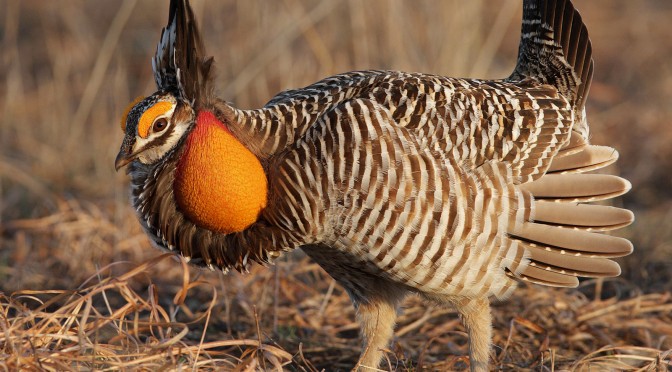The first results of Wind Wildlife Research Fund studies are providing new information about interactions between wind energy and wildlife – namely, bats and prairie grouse.
The Fund is a unique industry-led initiative that the American Wind Wildlife Institute manages. It pools resources to advance critical collaborative research on wind-wildlife interactions and solutions. In 2019, the Fund launched its first seven research projects, and results from three of these studies are now available or in publication.
Climate change remains the biggest threat to many species of wildlife, and wind energy has a pivotal role to play in reducing carbon emissions from the energy sector. In 2018 alone, wind energy, the country’s largest renewable energy source, cut over 43 million cars’ worth of carbon emissions. The industry is set to further reduce emissions in the future. According to AWEA’s recent quarterly U.S. Wind Industry Market Report, at the end of 2019 the U.S. near-term wind project pipeline was 44.2 GW—equal to almost half of the wind energy operating today.
Substantially increasing our nation’s wind energy infrastructure in ways that protect and conserve wildlife depends on finding solutions to wind-wildlife challenges that are scientifically sound and statistically valid, and the Fund focuses on research that will deliver these solutions. Its activities and priorities align with AWWI’s National Wind Wildlife Research Plan and are guided by an Advisory Council comprised of the Fund’s major contributors. Fund leaders work together to select the projects, and each individual company determines its level of support for each research project. Companies that contribute to the Fund also become Partners or Friends of AWWI, and contributors include both conservation organizations and wind companies.
“It is really encouraging to see that Fund research is already yielding tangible results that can help us understand risk and better target conservation efforts,” commented Joy Page from Defenders of Wildlife, AWWI Partner and a member of AWWI’s Board. “There has been a long-standing need for more credible, peer-reviewed information about how wind energy development affects wildlife, particularly for species of concern like migratory tree bats, and the Fund is helping to meet that need by generating new knowledge.”
Expert-reviewed reports from two studies, one investigating lesser prairie chicken responses to wind projects, and another looking at the relationship between landscape-level factors and migratory tree bat fatalities at wind facilities, have been published by AWWI and are now available. Another study comparing bat pre-construction acoustic activity and post-construction fatality rates has been accepted by a peer-reviewed journal where publication is expected later this year.
Wind Energy and Lesser Prairie-Chickens
“Placement of Wind Energy Infrastructure Matters: A Quantitative Study Evaluating Response of Lesser Prairie-Chicken to a Wind Energy Facility” presents the results of an investigation into the effects of wind energy infrastructure on lesser prairie-chickens (LEPC) over a three-year period at a Kansas wind energy facility.
LEPC are endemic to the North American Great Plains and have experienced range-wide population declines as their habitat has been lost or fragmented due to landscape changes. Wind-wildlife stakeholders have wanted to learn more about LEPC responses to wind energy infrastructure within LEPC habitats.
This study, the first to look at the effects of wind energy infrastructure on LEPC, found no negative effects on LEPC habitat selection or survival during the first three years of data collection at this wind facility, which is located in an agricultural landscape. With the support of the Fund, the study will continue for a fourth year in 2020 to verify initial findings and investigate the potential for LEPC delayed responses to wind energy infrastructure.
Wind Energy and Bats
“Landscape Factors Associated with Fatalities of Migratory Tree-Roosting Bats at Wind Energy Facilities: An Initial Assessment” used an extensive data set provided by the American Wind Wildlife Information Center (AWWIC) database to identify connections between landscape-level features and fatality rates at nearby wind facilities for three migratory tree bat species, hoary, eastern red, and silver-haired. These three species comprise approximately 72 percent of all bat fatalities at wind energy facilities. Understanding these associations can help inform siting and design decisions, but few studies have explored them.
The authors looked at relevant landscape metrics (e.g. land cover) at multiple spatial scales. Key findings include that factors influencing bat fatalities differed among regions and species; that fatalities of all three species were higher at facilities with greater urbanization (percentage of developed land) within 25 km; and that areas with multiple small or mixed small and large wetland patches may present increased risk. The study focused on sites in U.S. Fish and Wildlife Service Legacy Regions 3 and 5; further studies may help understand these relationships for different species in different Regions.
“Bat Activity Rates Do Not Predict Bat Fatality Rates at Wind Energy Facilities,” accepted by the peer-reviewed journal Acta Chiropterologica, presents Fund study findings that investigated the relationship between pre-construction bat acoustic activity and post-construction fatality rates at wind facilities to assess the effectiveness of using pre-construction acoustic activity monitoring to assess risk. The study found bat activity rates (based on bat echolocation surveys) prior to wind development did not predict bat fatality rates at wind energy facilities, and acoustic activity rates at operational wind facilities did not predict bat fatality rates that occurred during the same time period.
“The quality of information in these first reports underscores the value of investing in the Fund,” remarked Ray Kelly from Clearway Energy Group, Secretary of the Fund, AWWI Partner, and member of AWWI’s Board. “The wind industry’s ability to grow sustainably and deliver meaningful carbon reductions depends on minimizing wildlife impacts and maximizing conservation benefits. The scientific knowledge gained from Fund-supported research is vital to these efforts.”
In 2020, the Wind Wildlife Research Fund is supporting seven research projects. Some are new and others are continuations of 2019 research projects. The results of the projects will inform regulatory and business decisions in the wind industry, helping to achieve conservation outcomes.


